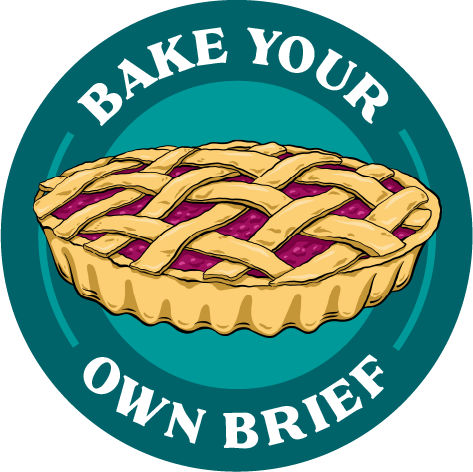Messy creative briefs suck! You know the ones, with missing information, secret deadlines and chaotic results. Let's fix that...
Messy creative briefs suck! You know the ones, with missing information, secret deadlines and chaotic results. Let's fix that...
Picture this:
You’re a professional chef running your own restaurant. You’ve got a full house booked tonight, and your signature dish is the only thing on the menu.
You get there niiice and early, ready to prep the ingredients and sort out your mise en place. You head over to your recipe station to get the recipe out for tonight’s special.
Your stomach drops. It’s not there.
You could try to work from memory, but even though you’ve made this dish a thousand times before, should you risk it?
If you do, you could wind up serving your diners something that wasn’t what they ordered, or were expecting, and leave a bad taste in their mouth.
You wouldn’t cook a meal for someone who is paying you for said meal without a recipe, or at the very least, a structure or plan of what you’re going to cook, would you?
Now, let’s say you’re a designer, and the diners are your clients, paying you for your creative services.
You want to serve up a delicious project that’ll have your clients drooling, and they want to get what they’ve ordered. But not only that, you want to wow them your professionalism and make sure they KNOW you’ve got your shit sorted
How do you make that happen?
A great brief.
Think of a brief like a recipe; each ingredient carefully selected to add balanced flavour, bind the ingredients, and help it bake evenly, so you’re left with the perfect meal every time.
It’s easy to understand, reliable and repeatable, and shows you the exact ingredients you need to start, a step-by-step method to bring it to life, and best of all, you can re-visit it anytime you need to while you’re cooking.
So, how do you make sure that your creative brief has all the right ingredients to plate up a tasty project that’s cooked to perfection and tastes incredible? Keep reading…
Want a comprehensive list of what you need to write the perfect brief for any project? Download my FREE checklist here
Your Briefing Ingredients List
1. A clear & mutual understanding of direction
If you’ve been a Creative for any amount of time, you’ll know just how critical it is for there to be a clear understanding of the problem the project is looking to solve and to agree on a clear pathway for how to make this happen.
If things aren’t clear from the beginning, the client may change their mind part-way, and without a brief to turn to, project timelines and budgets can blow out FAST. And no one wants any of that noise!
Chef’s note: a clear, foundational direction can be found by asking open questions and represented in a brief as a clear written explanation (with dot points, etc.), or a visual representation like a ‘from here – to here’ flowchart.
2. Acknowledged & agreed accountability from both parties.
A good brief outlines clear expectations for what each party needs to do and when, like how your client is responsible for providing necessary content at certain stages, or you as the designer are responsible for providing weekly updates on progress, and how you’re both responsible for showing your dogs on each video call.
Sure, you have the creative know-how and the subject matter expertise, but without the necessary information, copy, images or communication as and when needed, project milestones won’t be hit, and again, timelines and budgets can quickly blow out!
Chef’s note: accountability can be sprinkled into project milestones throughout a brief, with client/creative & design content or information check points built-in to the project timeline.
3. Crystal clear deadlines, timelines and milestones
This is probably one of the most important ingredients of a brief (though they’re all pretty critical) but this one can do the most damage if left unchecked.
The best briefs that deliver the most delectable projects have suuuper clear deadlines, milestones and overall project timelines from the very start (or even earlier if it’s possible!).
Ask questions in your brief so you’re aware of any bottom-lines for your client. Do they have a hard budget? A strict deadline? Are there any other clinchers for the project?
Chef’s note: This is not an area for open ended questions – you want yes/no answers, and if yes, what are the terms for the client e.g. Do you have a hard budget for this project? Are there any concrete deadlines for the project as a whole or for certain milestones?
4. Easy-to-follow steps for the process
As creatives, working with clients is our bread and butter. But as the ones with the most experience in the creative-client relationship, the parts that are clear to us about the process of a project may not be clear to our clients.
With things clearly broken down in the project brief, it’s easy to keep track of project progress, and your client can clearly see the step-by-step requirements on the projects’ journey to completion.
Chef’s note: This is another instance where a visual representation is super helpful, with the use of a project GANTT or flow chart depicting the stages & milestones, or a project management software that your client can access to view progress at any time.
5. Make it an accessible point of reference throughout the project
Having a thorough design brief is a safety net for both of you. It’s a point of reference for when something in the project inevitably goes awry – you both can go back to the project brief, take a look at the plans & information and recognise where things went wrong.
A brief can help you pull things into line quickly and easily. It’s a hard record of previously had and agreed discussions between client and creative, almost like a contract. You can be like ‘Hey, I’m noticing we’ve gone a bit off track. Remember in our brief on page X when we discussed doing Y at Z milestone?’.
Chef’s note: A brief is not a replacement for a contract, because a contract does not detail broken down project specifics. It is best to serve both an approved brief and a comprehensive contract. Like tapas! Both dishes at once, for you to share in their delicious benefits.
If any of this tasty goodness sinks in for you; let it be this, it’s that the MOST important part of a brief is to make sure you are asking the right questions for what you, the client and the project require.
Still not sure what questions to ask? Craving a briefing system pre-baked that you can serve yourself straight to your clients?
Take a seat at the table, my Hungry Creative! I’ve got a meal that’ll leave you stuffed.
I’ve put together a delicious, downloadable Bake Your Own Brief Builder Kit where I go way deeper into how a well-prepared brief can help you bake more profit into your creative crust – and as a garnish you’ll get access to the very same templates I use in my business with my clients (y’know, the one that brings over six-figures profit each year, consistently)








